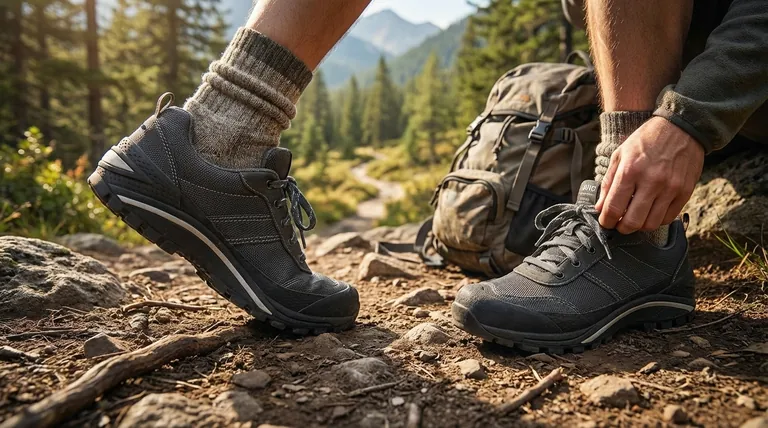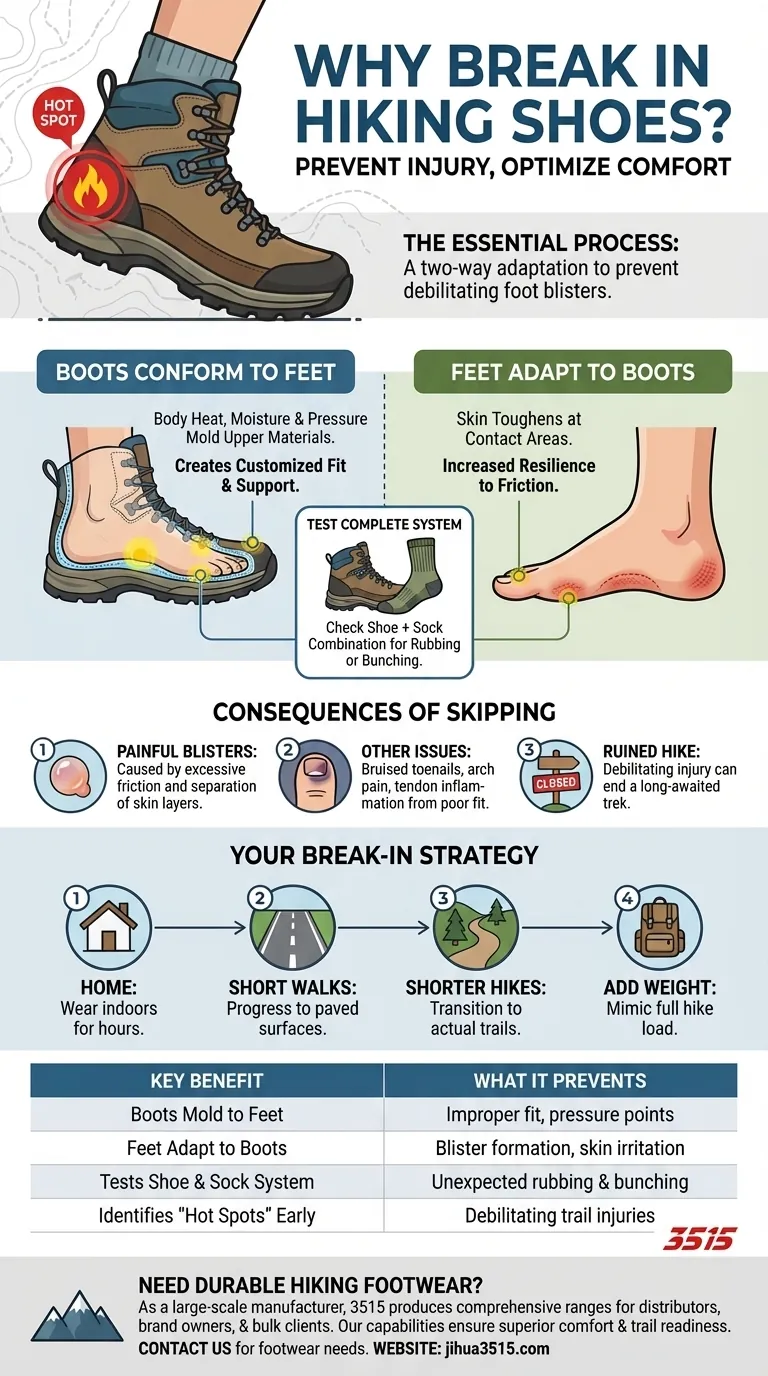The most preventable trail injury is also one of the most common: debilitating foot blisters. Breaking in your hiking shoes is the essential process of allowing your footwear and your feet to adapt to one another. This systematic adaptation identifies and resolves high-friction areas before they can cause the painful blisters and discomfort that can ruin a long-awaited hike.
The core purpose of breaking in hiking shoes is not merely to soften the material, but to run a critical diagnostic test. It's your opportunity to discover and fix potential "hot spots"—points of friction between your foot, sock, and boot—in a low-stakes environment before they become a serious problem on the trail.

The Mechanics of Breaking In: A Two-Way Process
Many hikers assume the break-in period is only for the boot, but it's a mutual adaptation. Both the structure of your footwear and the skin on your feet undergo important changes.
How Boots Conform to Your Feet
New hiking boots, especially those with leather components, are manufactured to a generic shape. The break-in period uses your body heat, moisture, and the pressure of your unique foot shape to slowly mold the boot's upper materials.
This process helps the boot conform to the specific contours of your ankles, the width of your forefoot, and your arch, creating a more customized and comfortable fit.
How Feet Adapt to the Boots
Simultaneously, your feet are also adapting. The skin responds to consistent, low-level pressure by slightly toughening up in key contact areas.
This gradual conditioning makes your feet more resilient to the friction they will inevitably experience during a long day of hiking, reducing the likelihood of blister formation.
Testing Your Complete Footwear System
A critical, often-overlooked function of the break-in period is testing your shoes and socks together. The thickness and material of your socks can dramatically alter the fit and internal volume of your boot.
Breaking them in as a complete system ensures there is no unexpected rubbing or bunching, confirming that your chosen combination works for your feet.
Understanding the Consequences of Skipping This Step
Starting a multi-day trek with brand-new boots is a significant gamble. Understanding what happens when friction goes unchecked highlights the importance of preparation.
The Anatomy of a Blister
Blisters are your body's response to excessive friction. Repetitive rubbing causes the outer layers of skin to separate from the inner layers. The body fills this gap with fluid to cushion the damaged tissue underneath, creating a painful blister.
Discovering "Hot Spots" Too Late
A "hot spot" is the precursor to a blister—a localized area of warmth or stinging caused by friction. On a short walk, you can stop and address it. On a long trail, miles from your destination, a hot spot can quickly become a debilitating injury.
The break-in process is designed to reveal these hot spots during short, safe walks, allowing you to make adjustments, change your lacing, or apply protective tape.
Beyond Blisters: Other Fit-Related Issues
An improper fit, which would be identified during a break-in period, can cause more than just blisters. It can lead to bruised toenails from downhill pressure, arch pain, or even tendon inflammation from a lack of proper support.
Your Practical Break-In Strategy
The goal is to gradually increase the duration and intensity of wear to mimic the demands of a real hike.
- If your primary focus is a perfect fit for a major trek: Start by wearing the boots around your house for a few hours, then progress to short walks on pavement, then to shorter hikes on actual trails, eventually adding the weight of a pack. This process should ideally take a few weeks.
- If your primary focus is a last-minute check: If time is short, wear the boots as much as possible in the days leading up to your hike, even just for daily activities. Pay close attention to any rubbing and be prepared to take preventative measures on the trail, like carrying blister tape.
- If your primary focus is testing a new boot and sock combination: You must wear the exact socks you plan to hike in during your break-in walks to ensure the system works as a whole.
Ultimately, taking the time to properly break in your footwear is the best insurance you can get for a successful and enjoyable hike.
Summary Table:
| Key Benefit | What It Prevents |
|---|---|
| Boots Mold to Your Feet | Improper fit and pressure points |
| Feet Adapt to Boots | Blister formation and skin irritation |
| Tests Shoe & Sock System | Unexpected rubbing and bunching |
| Identifies 'Hot Spots' Early | Debilitating trail injuries |
Need durable, comfortable hiking footwear for your next adventure? As a large-scale manufacturer, 3515 produces a comprehensive range of high-performance hiking boots and shoes for distributors, brand owners, and bulk clients. Our production capabilities ensure every pair is crafted for superior comfort and trail readiness. Contact us today to discuss your footwear needs and get a perfect fit for your customers!
Visual Guide

Related Products
- Durable Rubber Sole Outdoor Shoes Wholesale & Custom Manufacturing
- Durable Waterproof Rain Boots | Custom Manufacturer for Wholesale & Brands
- Durable Rubber-Soled Utility Shoes for Wholesale & Custom Brand Manufacturing
- Wholesale Safety Footwear Manufacturer for Bulk & Custom OEM Orders
- Advanced KPU Athletic Safety Shoe with Steel Toe Cap Anti-Slip Rotary Lacing System
People Also Ask
- What are some alternatives to hunting boots? Hiking, Rubber & Tactical Boots Explained
- What are the main applications of vulcanized rubber? Unlock Durability for Tires, Footwear & More
- What should be considered when choosing hiking boots for snake protection? Prioritize Fit & Materials for Safety
- How does cushioning work in hiking shoes? The Science of Shock Absorption
- How do hiking shoes or boots protect feet from environmental hazards? A Guide to Trail-Ready Footwear



















